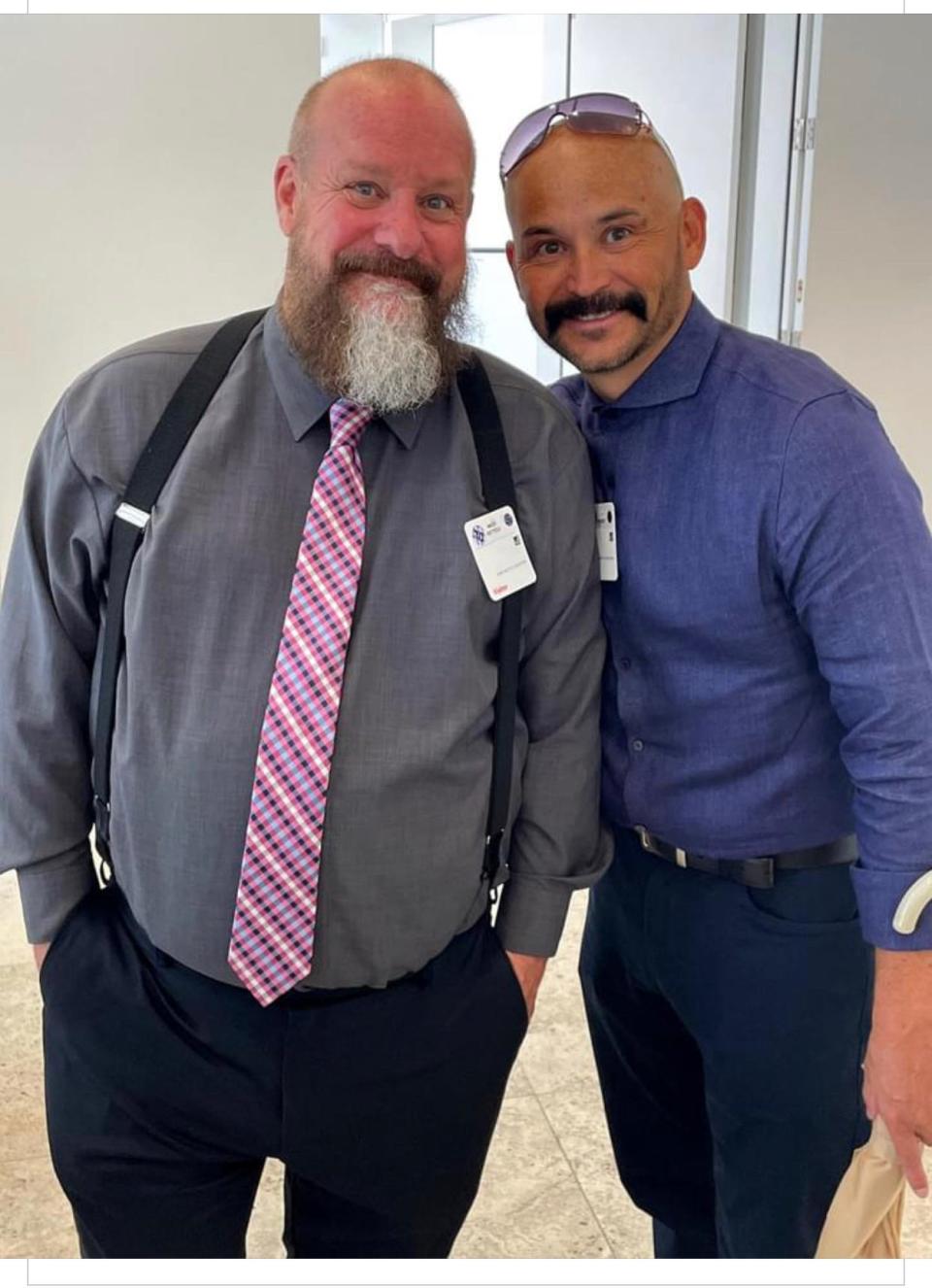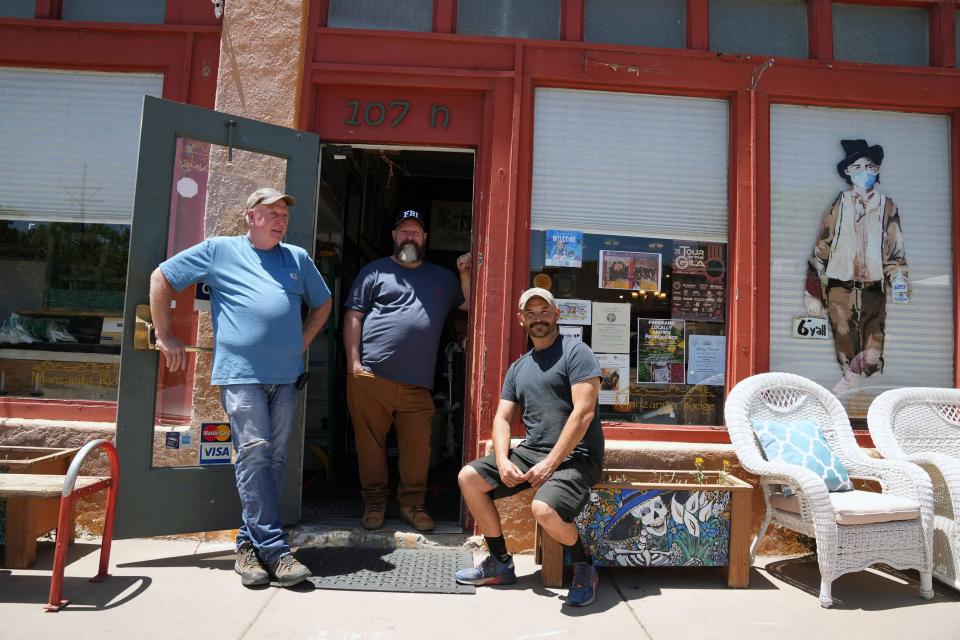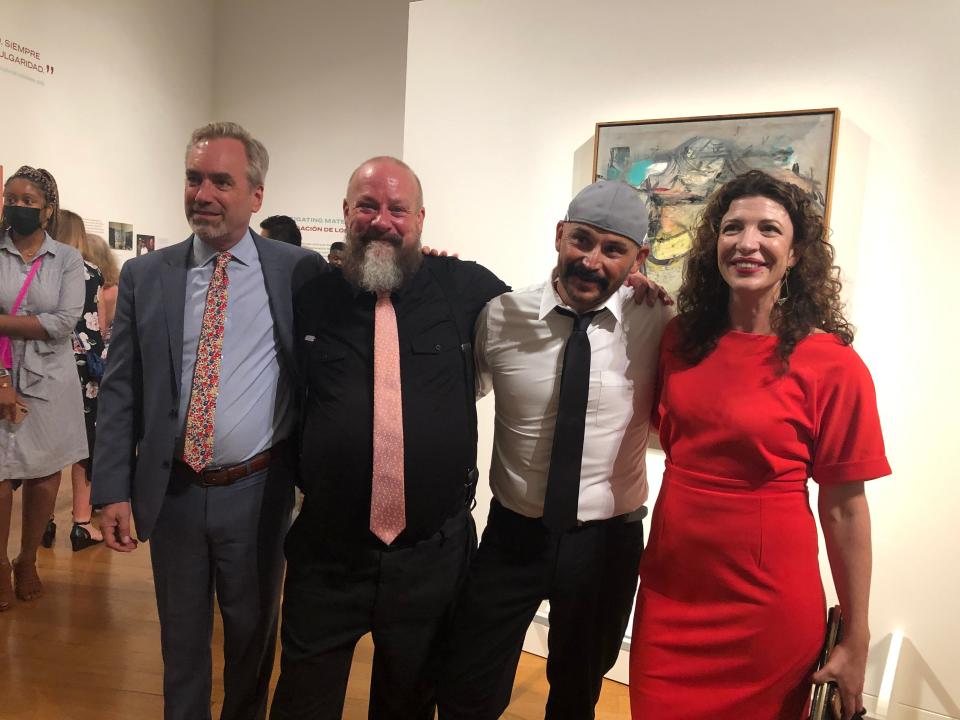These antique dealers found a stolen de Kooning painting. Now they’re the toast of the art world
LOS ANGELES — David Van Auker and Buck Burns stepped off an elevator and into a second-floor gallery at the J. Paul Getty Museum.
It was a Friday night, a time when the renowned museum is typically closed to visitors.
But they weren't just any visitors.
In 2017, as co-owners of a furniture and antiques store in Silver City, New Mexico, they made national news when they discovered a stolen Willem de Kooning painting in an estate sale and returned it to its rightful owners at the University of Arizona Museum of Art.
Now, on this Friday evening, they were about to see the painting for the first time since it had undergone conservation work at the Getty. They were accompanied by current and former museum staff and Getty painting conservators. Everyone chatted excitedly as they poured off the elevator, their voices echoing off the walls. They shared a special bond: A famous painting they were all connected to was back on exhibit after 37 years.
In the room's center was "Woman-Ochre," an oil-on-canvas painting estimated to be worth more than $100 million.

Van Auker and Burns were silent as they gazed at the painting. Burns shook his head and smiled. Van Auker put his hand over his heart. They stepped closer. The painting, made in the winter of 1954-55, depicts a nude woman with a grimaced face. The Dutch-American artist de Kooning used vivid hues of yellow, turquoise and crimson and a distinctive, gestural brush stroke.
"Wow," Van Auker said, wiping his eyes. "I'm speechless."
The crowd clapped and cheered.
For subscribers: The saga of Arizona's famous stolen de Kooning painting. New details paint picture of alleged thieves
"Olivia, come here," Van Auker said, gesturing to Olivia Miller, curator of the university art museum. She was the person who accepted a phone call on Aug. 3, 2017, from Van Auker when he thought he had found the museum's stolen de Kooning. They have since become fast friends. On Friday, she hugged Van Auker and Burns, as they celebrated another milestone in the painting's long journey back to the public eye.
"I love you guys," she said.

Burns thanked the Getty for the work. Then everyone took turns posing in front of "Woman-Ochre," taking group photos and selfies.
"What's interesting to me is the way this painting, this project, has kind of gathered people around it," said Andy Schulz, the university's vice president for the Arts and dean of the College of Fine Arts, during brief remarks before the private viewing.
Friendships have formed among current and former museum staffers, conservators at the Getty Museum and scientists at the Getty Conservation Institute. They all share a bond, a connection, over a work of art.
For subscribers: $100 million de Kooning was recovered in 2017. New details paint picture of alleged thieves
"Woman-Ochre" was donated to the university in 1958 and was considered a jewel in the museum's collection. When it wasn't on exhibit, it was on loan to other museums. Then, in 1985, it was stolen on the day after Thanksgiving in a brazen heist and remained missing for more than 30 years.
The Silver City antique dealers picked up the painting in August 2017 as part of an estate sale in a nearby town and, after customers began inquiring about whether it was a real de Kooning, Van Auker started Googling and came across an Arizona Republic article about the theft. He called the museum right away. Within days, "Woman-Ochre" was back home.
Miller said on Friday that although the theft showed the worst side of people, the recovery and conservation represent "the best parts of people." Many people played a role in getting the painting back and enabling the art to be on exhibit again, she said.
Van Auker and Burns last saw the painting in March 2019, during an invitation-only, one-night exhibit at the university art museum. Then the painting was moved from Tucson to the Getty for research, analysis and repairs.
Getty scientists and conservators quickly discovered the 40-inch tall by 30-inch wide painting had been terribly damaged. Horizontal cracks marred the surface, where the thieves had cut the painting out with a sharp object — possibly a box cutter — and ripped it from a backing canvas. The painting had been covered with two layers of varnish, obscuring the vivid colors and giving a grayish or yellowish tint.
The Getty undertook the project at no charge to the university in exchange for being able to display the de Kooning for a few months after conservators finished their work. The work took nearly three years. The exhibit, "Conserving de Kooning: Theft and Recovery," opened June 7 and runs through Aug. 28.
The focus is back on the painting, not the damage, said Ulrich Birkmaier, the Getty Museum's senior conservator of paintings. You can still see traces of the painting's tumultuous history if you look closely, he said. But more importantly, the painting "reads" well again and has aged gracefully.
He told the assembled crowd on Friday, over appetizers of shrimp cocktail and empanadas, that it is heartwarming to see so many people who are so closely connected to the painting. Referring to the antique dealers, he said:
"We're just in awe of everything you've done for the painting."
The antique dealers found "Woman-Ochre" in the bedroom of a deceased, retired couple, Jerry and Rita Alter, who lived in rural Cliff, New Mexico. Jerry Alter had been a music teacher, Rita Alter a school speech pathologist. The couple spent nearly every vacation traveling to exotic locations. The FBI won't comment on whether the couple were the thieves.

But circumstantial evidence links the Alters to the crime: A family photograph places the couple in Tucson on Thanksgiving Day in 1985, the day before the theft. The photo eerily resembles a composite sketch of the thieves. Witnesses said the thieves drove a red car; the Alters had purchased a red Toyota Supra earlier that year, according to their travel journal.
The painting likely hung in their bedroom for years because heavy dust had accumulated on the gold commercial frame. It was behind a bedroom door so it could only be seen from inside the bedroom, when the door was closed.
By contrast at the Getty, "Woman-Ochre" is now viewed by a steady stream of visitors. They stop to read about painting's conservation and watch a short video about the theft and repairs. The now-famous painting is in good company. Just around the corner is a gallery with several Rembrandt paintings, including the famous "Rembrandt Laughing."
Finding the de Kooning has been a life-changing experience for the Silver City antique dealers.
At least once a week, someone will come into Manzanita Ridge, their 10,000-square-foot store, and ask about the stolen painting. Van Auker never tires of telling the story. It’s the most exciting thing that has ever happened to him. He has been interviewed more times than he can count. People have called the store, just to say, "thank you."
So many years have passed, no one at the university quite remembers the details of the $10,000 reward that was originally offered for the painting's return. The antique dealers said they wouldn’t accept one anyway.
The university gave them the gold frame that once housed the de Kooning after it was stolen. Van Auker proudly hung the empty frame in the guest house he and Burns own, in the same spot where they originally intended to hang the de Kooning before finding out it was real and stolen.
The Getty exhibit was something Van Auker and Burns looked forward to for weeks. They bought new clothes. Van Auker lost weight. They took time off work so they could fly to Los Angeles. Their third business partner, Rick Johnson, stayed in Silver City to care for his mother and four dogs. But he is planning to see the painting when it goes on exhibit in Tucson.
Van Auker and Burns were especially excited to see a photograph of themselves and Johnson and their names displayed in the Getty exhibit. The photo caption reads, "A 2017 photo of the three antique dealers who called the FBI after they realized they had purchased a stolen painting (left to right): Rick Johnson, Buck Burns, and David Van Auker, all of Silver City, New Mexico."
Van Auker and Burns took a selfie in front of the photo of themselves, being careful not to block Johnson's head so they could all three appear in the photo.
Once that was done, Van Auker was no longer speechless.
"I'm absolutely blown away," he said, his eyes still wet with tears. "I had no idea I would have this kind of emotion seeing it finished. I'm honored, touched. I'm so thrilled I got to be part of this."
And the journey is not over.
"Woman-Ochre" will come back to Tucson for exhibit, beginning Oct. 8.
Republic reporter Anne Ryman was the first journalist to break the story that "Woman-Ochre" had been recovered and has written extensively about the painting. Have a question about the painting? You can reach her at anne.ryman@arizonarepublic.com or 602-444-8072. Follow her on Twitter @anneryman.
Reach the reporter at anne.ryman@arizonarepublic.com or 602-444-8072. Follow her on Twitter @anneryman.
Support local journalism. Subscribe to azcentral.com today.
This article originally appeared on Arizona Republic: Antique dealers who found stolen Willem de Kooning painting honored

